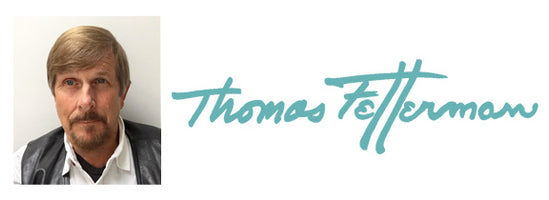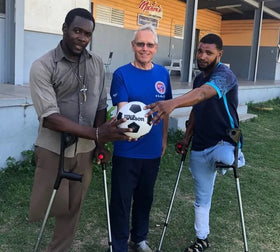My Disability Made Me Do It by Thomas Fetterman
I have been walking with crutches now for over 43 years since I had polio when I was a child of eight. At the same time, though I did not realize it, I started my problem solving career as an inventor.
In those days there was no choice. There was no wheelchair access. As an 8-year-old, I had no idea of how daunting stairs could be and how they could separate the able from the disabled. Fortunately my physical therapist knew. She worked with me daily in a vigorous routine of stretching exercises and torturous hot steamed pads, cajoling me, bribing, intimidating and caressing me to comply.
This wonderful woman with a thick European accent was relentless. She knew that if I were to live in the mainstream with my family and peers, I needed to take steps.
My first piece of assistive technology was a full leg brace which was so massive and formidable that it would have made the 'Road Warrior' envious. Then came my first set of wooden Sister Kenny armband crutches.
When I stood upright for the first time in over a year, my head spun like a top. It took several days to rid myself from this altitude sickness but it was worth it. I was vertical! I learned to walk. On flat ground the crutches and brace worked beautifully, in an ungainly sort of way, but stairs petrified me.
By this time I had become quite proficient at climbing the clean, smooth wooden stairs in my family's house on my butt, step by step. My slow climb to the top was more than made up for by my rapid descents. The stair problem became more daunting when I started back to school again after missing a whole year. The school stairs were iron and cement, not as clean as the ones at home and a lot more of them. I was allowed to leave class five minutes early to negotiate the stairs without being trampled and to save face. Climbing these public stairs on my butt was hun3Biating and it made my hands and pants look as though I was orphaned. It was just what I needed to get over the fear of failing. I was crutching up and down the stairs using the railing in just a few weeks. In the months to come my upper body strength kicked in and my agility improved immensely. I was soon able to forego the railings and pull myself up three steps at a time even with a loaded book bag. I was back in the mainstream! I could go anywhere. My clunky heavy leg brace and my wooden crutches did the job .... I was hooked on assistive technology!
I did not realize it then but I was becoming a crutch expert and inventor out of need. I was constantly breaking my crutches and brace. I was forced to maintain and repair them. I began my collection of spare parts. I became 'handy'. I began making reacher gadgets and carrying de- vices. My father and I built my first go-cart when I was 12 so I could keep up with my friends. When I was 15, 1 made hand controls so I could drive my brothers three on the column, flat head 8 Ford, up and down our driveway about 1000 times. I began seeing obstacles as a challenge. Solving these problems was its own reward.
I soon outgrew the resources in our basement and began outsourcing for materials and technical support. During my go-cart making years, I developed a friendly relationship with the local lawnmower mechanic. I would tell him what I was trying to do and he would show me how it could be done. He had the expertise and the tools and he also loved problem solving. He was a great ally. I learned that there are many generous professional people quite willing to assist in problem solving.
Many years later I developed shoulder pain. My doctor said it was caused by the pounding resulting from years of crutch use and recommended that I take aspirin and limit my activity. I decided it was time to develop a crutch with a shock absorbing system.
By this time I had graduated to aluminum forearm crutches and I began by putting springs inside the crutch tubes. The effect was good but the mechanics were flawed. The springs needed constant maintenance and eventually they wore the tube wall so thin that a crutch folded in half when I was stepping off a curb. Fortunately I had already become an expert on falling. I was not hurt but it was clear that I needed a fresh approach.
I came up with the idea of using a half-inch- thick slice of a sponge rubber ball sandwiched between the rubber treadpiece and the upper body of an ordinary crutch tip. The result was great but unfortunately it did not last. In just a week of walking, the sponge rubber became flat as a pancake, having lost all memory of its former self. It was time for me to call in some outside help! Using the Business To Business Yellow Pages I phoned a rubber manufacturing company named RUBATEX. A representative came out to my house and I showed him my prototype tips. He educated me about the difference between rubber with its short memory and urethane's long memory and told me about a patented urethane gel that absorbs up to 80% of the applied shock by turning it into beat. This protective gel is currently being used in the sports industry for protective equipment like inside baseball catchers mitts, volley ball shoes and safety helmets. He gave me the name and number of a urethane company that was his direct competitor. His help was essential to my success.
I have since found numerous helpful manufacturers quite willing to lend their expertise to my projects. I have also met many want-to-be inventors who are afraid to tell manufacturers the details of their invention for fear that they will steal their ideas. Manufactures are specialist in problem solving. They want to manufacture your product and are willing to invest their time and expertise with the hopes of getting the manufacturing work. Being coy with them is counterproductive.
I began studying sneaker design because I wanted to design the NIKE AIR" of crutch tips. Crutch tips, like the canvas sneakers of old, had not evolved in many years. By transferring some of the sport-shoe technology to crutch-tip design, I was able to design a highly evolved shock absorbing, long lasting crutch tip for which I was eventually awarded a US Patent No. 4 881 564.
1 went to my local library and looked up crutch tip manufacturers in the 'Thomas Register'. I then contacted the major manufacturers and made arrangements to send them my design. I got back many courteous rejection letters stating that my costs would be too high to be competitive in a extremely price sensitive marketplace. What I discovered was that the crutch manufacturing industry focuses primarily on the short-term crutch user market because their numbers are great compared to long term crutch users like myself. This discovery prompted me to dedicate my shock-absorbing crutch tip technology to long- term crutch and cane users because our design needs are more demanding and have more consequences. I convinced my two brothers to invest money to further explore the viability of my design.
My next bit of luck came when I discovered (in the phone book) a family owned and operated rubber molding company in my area. When I proposed to them that we encapsulate a pad of urethane rubber tip, they were intrigued. They committed many hours to the project and created a trade-secret manufacturing process as well.
Several prototype molds were made as I learned about what I wanted and what was possible. After countless attempts we were able to finalize rela- tionships between the rubber density, the urethane pad size and density and the strength requirements of a crutch tip.
Finally I had a tip that felt just right. I sent several pairs to other full-time crutch users for their evaluation. I wore my new tips with glee. They were so much more comfortable than the ordinary hard bodied rubber crutch tips and be- cause they flex and have torsion, they grabbed the ground very aggressively too. As an added bonus they wear 3-5 times longer than ordinary tips, so even though they are more expensive up front, they last so long that they are actually less expensive.
I had excellent feedback from the people test- ing for me. Every step I took reminded me that I had a great product and again I tried to interest tip manufacturers by sending them samples. Again I was politely refused and so I decided to manufacture them myself and spent $13,000 (of my brother's money) to make a production mold. I designed a box and literature and soon had tips by the case.
To introduce my new PERFORMANCE tips, I took a booth at an Abilities Expo where disabled end-users gather to see new products. When a crutch user walked by, I invited them to let me put a pair of my PERFORMANCE' tips on their crutches and walk around the show. Typically they walked a few feet, smiled and reached for their wallets. I asked these good people to visit the booths of the large crutch manufacturer and tell them how much they liked my tips. I ended up selling over $2500.00 worth of tips in just 3 days and got the interest of the head of the ambulatory division of a large manufacturer who became my 'champion' within that company.
There is nothing quite like the 'proven sales' of a patented product along with glowing testimonials from users to inspire commitment from big business. On the third time I offered my product to the same large manufacturer, they entered into negotiations with me to buy my patent. A year later we signed a contract that amounted to $100000.00 up front plus royalties. The company proceeded to spend a considerable sum of money to build a large production mold and to create packaging and sales literature. Their new product was dubbed the TORNADO tip and was well received by the long-term crutch user market.
Unfortunately, the TORNADO tip project languished after my 'champion' was moved to head a new division. Fortunately the company maintains a high ethical standard so when I asked them to either give the project a large cash infusion or give the whole project back to me. They gave the project back to me and because they do not want disappoint their customers who use the TORNADO tip, they refer them to me.
To date, more than 20 000 pairs of my tips have been sold. This success has provided the opportunity to design and produce an entire line of high style, high function custom-built crutches, along with accessories like shock-absorbing gel filled hand grips, wet-slip-resistant crutch tips and ice tips for canes and crutches.
While my business is still consuming money as fast as it comes in, I am able to accumulate a great deal of 'emotional income' from the accolades and praise I receive from other long-term crutch and cane users. They phone and write to tell me that my products have truly made a positive difference in their life. I know my life is better!

